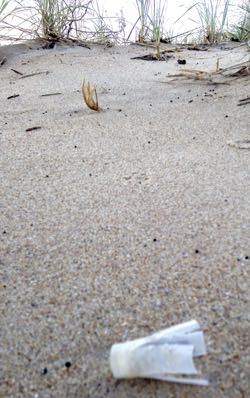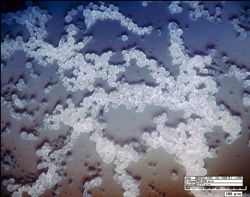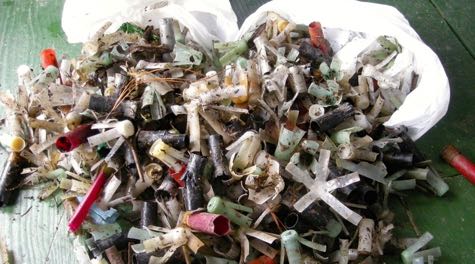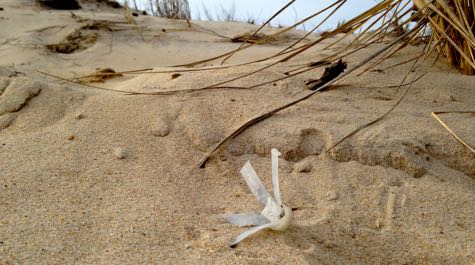VIMS shoots to reduce pollution from spent shotgun shells
Project earns support from Commonwealth Research Commercialization Fund
A team of researchers at the Virginia Institute of Marine Science has earned a state award to further develop a biodegradable alternative to the plastic “wad” that separates pellets from gunpowder inside a shotgun shell. Wads from spent shells are hard to retrieve, unsightly, and pose a threat to wildlife.
Virginia Governor Terry McAuliffe announced the $83,971 award last week. It was 1 of 38 awards dispensed from the $2.8 million Commonwealth Research Commercialization Fund, whose goal is to support promising research in targeted areas including advanced manufacturing, cybersecurity, and life sciences.
“The CRCF program advances research with potential for economic growth in Virginia,” McAuliffe said in making the announcement. “In order to compete with other states and globally, we must focus on early stage economic development. These investments are planting seeds that are helping us grow the new Virginia economy.”
Dr. Kirk Havens, assistant director of VIMS’ Center for Coastal Resources Management and the project’s lead investigator, says “Plastic shotgun wads are very common items in beach cleanups. They pose a particular environmental threat in freshwater and estuarine waters and marshes, where they can enter the food web as non-degradable plastic debris.”
 Manufacturers produce billions of wads each year worldwide, and in the U.S. alone, there are more than 3 million hunters using shotguns to target waterfowl. Wads can also be released by hunters seeking other animals, and during skeet shooting competitions and military training operations. Designed to improve shot performance and protect the barrel, wads move along the barrel’s length with the shot and are thus ejected some distance away, making them hard to retrieve.
Manufacturers produce billions of wads each year worldwide, and in the U.S. alone, there are more than 3 million hunters using shotguns to target waterfowl. Wads can also be released by hunters seeking other animals, and during skeet shooting competitions and military training operations. Designed to improve shot performance and protect the barrel, wads move along the barrel’s length with the shot and are thus ejected some distance away, making them hard to retrieve.
Plastic wads have been found in the stomachs of birds like albatross—presumably because they resemble the squid the birds like to eat—and over time can break into smaller and smaller pieces that persist in the environment. These “microplastics” can absorb toxic pollutants and are small enough to be ingested by worms, mussels, and crabs and then transferred up the food web.
The goal of the VIMS research team, which also includes David Stanhope, Dr. Donna Bilkovic, and Kory Angstadt, is to further refine and test a biodegradable shotgun wad they have developed in their lab. The wad is made of a natural material that has many of the same characteristics as plastic but completely biodegrades into water and carbon dioxide when subjected to the elements.
Havens says “Our wad is made of PHA, which is already present in aquatic environments. Bacteria produce PHA as a small granule to store energy, similar to humans storing energy as fat. When PHA comes into contact with aquatic environments, the resident bacteria recognize it as a food source and consume it.”
The VIMS team has already fashioned PHA wads that can be packed in a casing and fired; they will use the CRCF funds to conduct additional firing tests related to muzzle velocity, barrel pressure, shot patterns, and the extreme temperatures encountered while shooting. They will also continue to test PHA blends of various 'toughness' for different applications. Their ultimate goal is to work with shell manufacturers to bring the product to market.
 This is not the first time that Havens and his team have turned to PHA for help in developing biodegradable items for use in the marine environment. They previously used the substance to develop biodegradable panels for crab and lobster pots, and are also testing it as a potential substitute for the plastic microbeads found in many toiletries and skin-care products.
This is not the first time that Havens and his team have turned to PHA for help in developing biodegradable items for use in the marine environment. They previously used the substance to develop biodegradable panels for crab and lobster pots, and are also testing it as a potential substitute for the plastic microbeads found in many toiletries and skin-care products.
CRCF Funding
Managed by the Center for Innovative Technology, the CRCF is aligned with and guided by the Commonwealth Research and Technology Strategic Roadmap. During this most recent round of CRCF funding, applications were invited under 6 programs—Commercialization, Eminent Researcher Recruitment, Facilities Enhancement, Matching Funds, Small Business Innovation Research Matching Funds, and Small Business Technology Transfer Matching Funds—to support the private sector, academia, and nonprofit research institutes across the state.
Secretary of Technology Karen Jackson says, “CRCF provides seed funding necessary to advance cutting-edge research and promote the commercialization of exciting new technologies.”
Also earning a CRCF award was Gang Zhou, associate professor in William & Mary’s Department of Computer Science. Zhou was awarded $99,998 for his project “Reducing Smartphone Application Delay through Read/Write Isolation.”
The complete list, along with award recipients from previous solicitations, can be accessed at http://www.cit.org/initiatives/crcf-awards/.



